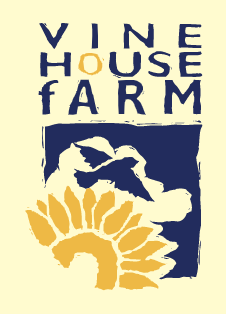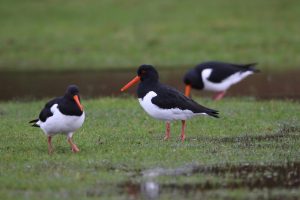
We’ve had a wonderful April; seldom have we had so much constant sunshine – 20 days of cloudless skies. With the humidity getting down to 45%, no wonder our fields dried out so quickly. Not surprisingly, April has been warmer than average, just five warmer Aprils in the last 50 years, with all of those occurring in the last 20 years. Rainfall, as we know, has been below average with a total of 30 mm for the month, 22mm of that falling in the last three days of April, our average for the past 50 years being 39 mm. Statistically, February, March and April are our three driest months of the year.

We are lucky to be farmers in these difficult times. Life has been going on, not quite as normal, but everyone on the farm has been putting in a full day’s work. Prices for our crops are down a bit – especially oil seed rape, as the price of that is linked to the price of oil. Oil seed rape was one of our best crops, but because the seed hasn’t been treated with a neonicotinoid seed dressing for the last four years, flea beetles have devastated most crops. Some have failed completely, most have a reduced yield and now that the price of oil has come down, there will be a lot less grown. The rape seed was specifically treated to stop the flea beetle eating the rape plant but the neonicotinoid disorientated bees so the chemical was banned.
No one could ever imagine that our land would dry out so quickly as it has done. The drying winds and many sunny days during March and April helped. Most of our land is quite heavy, as it has quite a lot of clay in it. To make a good seedbed in the Spring, we needed a frost mould – made by having several frosts, each gradually crumbling the soil. That did not happen this winter. We ploughed the land when it was wet, as we had no option, and it stayed stood up as we ploughed it. We have had to throw all the tractors and power harrows we have at the land to make seed beds. Fifty years ago all we had were harrow rolls and disc harrows, which would have been no use at all. We would have been dicing and rolling the land, and by the time we had a seed bed, it would have dried out so much nothing would have grown. Two fields for potatoes were so dry and hard we could not make a suitable seedbed so we had to irrigate them first and we now have a lovely seed bed on those two fields.
As we haven’t been interrupted by bad weather, we are left with just 15 acres of potatoes to plant. We still have to plant our bird seed, which is not normally drilled until early May. Any seeds drilled during the last ten days of the dry weather would not have grown without the recent rains, so they have done us a lot of good.
Our next job on the farm will be drilling the canary seed, millet and the sunflowers in that order and as soon as possible while we have moisture in the soil. After that we will have to protect the sunflowers from pigeons – while they are emerging they are very attractive to the pigeons, but once they have come up and the cotyledons have opened up, the pigeons have no interest in them. Most seeds, after they have been sown, put a root down and then send a shoot up so once through the ground, the cotyledons are formed. Sunflowers act differently by putting a root down and the seed itself, without the husk, is pushed up and as it emerges through the soil it breaks into two and the cotyledons are formed. It is the sunflower heart that is pushed up to break into two, no wonder the pigeons find them so tasty.


Farms this year are very different habitat from what they usually are at this time of year, due to the unprecedented wet weather we had last year. For the past 20 years, most farms have been 75-90% Winter cropping, but this year they are 75-90% Spring cropping and many of the dykes and ditches have been cleaned out.
Reed Buntings and Sedge Warblers will be returning to the dyke they nested in last year – they may find there is no vegetation in that dyke. Skylarks will be nesting a bit later. These semi-redundant dykes and ditches do need cleaning out every so often, but not all in the same year.
Reed Warblers will be the first birds to nest in those newly cleaned out dykes as they like vertical reeds to nest in. After two years, Sedge Warblers and Reed Buntings will nest there, as they like a tangled vegetation to nest in. After 10 years, when the dyke has become dry, Whitethroats will nest in them.
Although the winds have been in the NE here, our summer migrants are all arriving on time. They are so fantastic, it is the Warblers I am thinking of – most of them travel singly, flying at night. However, when I hear the first one, I probably hear a second one of that species the next day. Most of our Fenland Warblers have arrived now, Blackcap were the first, then Sedge Warbler, Whitethroat and Lesser Whitethroat and finally Reed Warblers. By the time you read this, most of them will have arrived. We have had one species that has been here all winter – the Cetti’s Warbler. Normally heard on nature reserves, but we have had one on our farm near the Welland for over a year now. This is in an area where we have dug a pond and there is an overgrown hedge. The NE winds may not have hindered our warblers arriving because further south the winds were probably SE, but they have hindered the Fieldfares leaving. On April 25th, I saw a flock of about 25, these could well be birds that nest north of the arctic circle, as I do know that Fieldfares in Belarus will have young in the nest now. The snow melt does not come until the end of May near the Arctic Ocean, so they have plenty of time to get up there still.
So far, on my surveys this Spring, Skylark numbers seem to be down and that could be due to the dreadful weather we had in June last year. It also doesn’t look very promising for the Barn Owls, as there are too many flying in daylight here in South Lincolnshire.
Our wetland in Baston Fen is doing very well, lots of nesting Lapwing with a few young running about. Five drake Shoveler are sitting around, meaning that the ducks are most probably on eggs. Three drake Gadwall and five pairs of Redshank are yet to go down on eggs. There are a few Snipe around still, two pairs of Little Ringed Plover, two pairs of Oystercatchers and three pairs of Tufted Ducks nest prospecting. I have also seen three pairs of Coot, Sparrowhawks and Marsh Harriers around.
The Moorhens on our garden pond are doing well. Five young hatched in the floating house that we made for them and, 10 days later, we still have five young. Moorhens do not nest in the same nest twice, so this house has four rooms and each room has its own entrance. This means they can nest in the house out of sight from overhead predators all through the summer. We built this floating house because our local Moorhens have been declining in numbers, and I didn’t want another species to disappear from the garden. In fact we have built five floating houses that are now all on ponds around the farm.
Talks & Events
Due to the current situation the Farm Walks in May & June are cancelled. All ticket purchases will be refunded.
We will advise nearer the time if the walks in July & August will be cancelled or still go ahead



